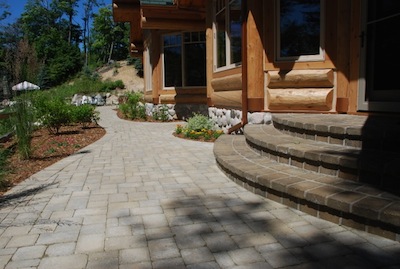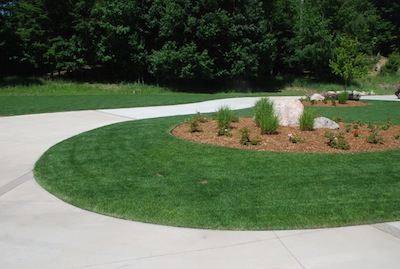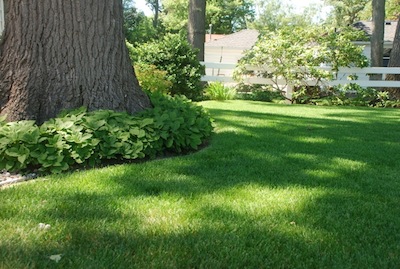Planting Beds
Planting beds are a wonderful way to add variety and beauty to your outdoor spaces, and provide a environmentally-friendly alternative to traditional grass lawns.
Grass lawns are a monoculture which require tremendous amounts of water, fertilizers, and toxic chemicals to remain green and healthy. Many in the green home movement are looking for ways to shrink, or even replace completely, grass lawns. Replacing portions of a grass lawn with much lower-maintenance ground covers, patios and walkways, and planting beds will create healthier outdoor areas for you to enjoy and spend time in.
Planting Beds for Landscape Variety
A planting bed is basically any landscaped area that isn't grass lawn. Planting beds will add color and variety to any outdoor space, and since almost any type of plant is easier to maintain than grass, the more planting bed space you have, the more time, money, and water you'll save as a result.
Choosing a Location
Planting beds can be placed just about anywhere to create unique, inviting spaces. Areas where something other than grass lawn might be better are excellent places to start:
- Areas overgrown by weeds
- Spots where grass has trouble growing, such as shady or hilly areas
- Areas where grass lawn is difficult to manage such as around trees or on steep slopes
- Anywhere where privacy is desired
- Any location where you would like to add a splash of natural color or variety
Creating a Design for Your Planting Bed
There are many places to turn to for design ideas; the best place to start is your very own imagination. Any landscaped area should first and foremost reflect your personal tastes, as well as fulfill any design requirements you're seeking (such as privacy as listed above). If a landscape is created to your satisfaction, there are no rights or wrongs.
To get ideas or help for creating a planting bed, there is no shortage of places to look; landscape magazines, software applications, garden design centers, even hired landscape design professionals. There are so many wonderful plants and design concepts out there to help you create your dreams.
Any designs you choose should account for the particulars of your actual physical space: site conditions, existing plant life, topography, climate, and the intended use of the space. When resources such as time and money are a factor, planting beds can easily be designed and created in phases over time. A proper design will save time, energy, and money. Landscaped areas are created for enjoyment and relaxation; the design process should not be an exception.
Choosing Planting Bed Locations
As mentioned earlier, planting beds can be located just about anywhere on your property. Your first planting beds can be placed along the property borders or in the center of lawn areas to provide visual contrasts. Placing planting beds in visually-prominent focal points around the outdoor space is another popular concept. These areas are usually around a home's entrance, outside frequently-used windows (for nice views from inside the home) or near outdoor patios or decks.
Plant Choice is Important!
Perhaps the most important decisions to make when designing planting beds is what type of plants to use. For most purposes, you should choose low-maintenance, drought-resistant plants. These include shrubs, trees, groundcovers, and perennials. Luckily, in most situations, the plants that meet these criteria are often native species. From a green perspective, choosing native plant species is important to prevent the introduction of invasive plants. Native plants and trees also provide beneficial food and shelter to the birds, animals and insects that you share your outdoor spaces with. Native plants also typically require much less toxic fertilizers, insecticides and pesticides to keep healthy.
It's also important to choose plants that fit well with the prevailing conditions of the planting bed location: some plants don't do well in high-sun areas, and vice versa. Like the design process, there are many outlets that provide good information on what plants thrive where. Doing your homework ahead of time and choosing the right plants will save lots of time and plant maintenance down the road.
Planting Bed Installation
Actually creating your planting beds needn't be a back-breaking chore. Again, landscape work and gardening should be a relaxing and rewarding experience. Here are some tips for planting bed installation:
- Lay out the shape of the planting bed with a garden hose, rope, or other material. Curves look great and are easier to mow around than angles. Be creative !!
- Spray some athletic field paint along your line and remove your hose or rope.
- Cut and dig a new edge 4” deep and 6” wide along the painted line.
- Remove the grass inside the edge with a shallow spade (put the unwanted turf in your compost bin). You can also kill the turf by covering it with a sheet of plastic for a few weeks. Try not to use chemical grass killer such as Round Up. Keep it green!
- You can place a border around the bed, using brick pavers, landscape edging, or leave a natural border.
- Plant the new plants as directed, mixing in some compost as you go for nutrition.
- Add mulch; this helps the soil retain moisture as well as giving the bed a nice appearance.
- Water the new plants regularly (according to their specific moisture requirements) until they are established. But remember, too much water can be just as harmful as too little.
Planting Bed Suggestions
As we mentioned earlier, landscaped planting beds should always first and foremost reflect your personal tastes. If a particular layout or plant looks good to you, that's all that counts. There are some things you can do to give your palnting beds real visual impact, as well as make them easier to care for. These include:
- Plant only special or "specimen" plants by themselves; these can be plants with exceptional features such as vibrant color. Isolating them gives draws attention; other plants should be planted in groups of three or more to add variety to the bed.
- Arrange plants in layers of different heights; shorter plants in the foreground, larger ones in back.
- Plant grouped plants close enough together to help crowd out unwanted weeds, but not close enough that they grow into each other.
- Place different plants that have similar maintenance/watering needs close to each other; this saves maintenance time and helps conserve water.
A Note About Mulch and Ground Covers
As noted above, adding mulch and other ground covers to your new planting beds is critical for the health of the plants and soil. There are a variety of ways that mulch are beneficial; it helps retain moisture in the soil, inhibits weed growth, moderates the soil temperature, and controls erosion. Forms of mulch include wood chips, shredded leaves or grass clippings.
With proper planning, design, and plant choice, you can create imaginative and beautiful planting beds for your outdoor spaces, all while minimizing your yards' impact on the natural environment.
comments powered by Disqus







































































